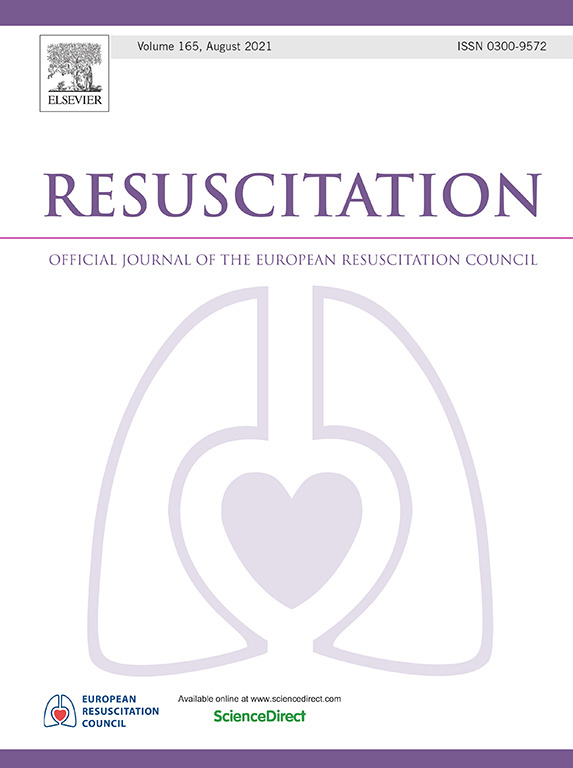意外低温在溺水患者院外心脏骤停中的作用:一项基于全国登记的队列研究。
IF 6.5
1区 医学
Q1 CRITICAL CARE MEDICINE
引用次数: 0
摘要
目的:本研究旨在调查全国溺水患者院外心脏骤停(OHCA)的低体温与死亡率或不良神经预后之间的关系。方法:这项全国性的、基于登记的队列研究报告了OHCA溺水患者遵循Utstein溺水方式的住院数据。2016年至2021年,在丹麦心脏骤停登记处发现了OHCA溺水患者。主要结局是OHCA和意外低温患者溺水事件发生后180天的死亡率或不良神经预后(对应于修改的Rankin量表[mRS]评分>3)。结果:本研究确定了118例OHCA溺水患者,发现与正常体温组相比,低温组在溺水事件发生后180天的mRS>3率增加(74%对18%)。体温过低的OHCA溺水患者与体温过低的OHCA溺水患者相比,在180天内有更高的死亡风险或较差的神经预后。这种关联可能是由诸如长时间浸泡和心脏骤停等混杂因素来解释的。进一步的研究是有必要的。本文章由计算机程序翻译,如有差异,请以英文原文为准。
The role of accidental hypothermia in drowning patients with out-of-hospital cardiac arrest: A nationwide registry-based cohort study
Aim
This study aimed to investigate the associations between hypothermia and mortality or poor neurological outcome in a nationwide cohort of drowning patients with out-of-hospital cardiac arrest (OHCA).
Methods
This nationwide, registry-based cohort study reported in-hospital data on drowning patients with OHCA following the Utstein Style For Drowning. Drowning patients with OHCA were identified in the Danish Cardiac Arrest Registry from 2016 to 2021. The primary outcome was the rate of mortality or poor neurological outcome (corresponding to a modified Rankin Scale [mRS] score > 3) at 180 days after the drowning incident in patients with OHCA and accidental hypothermia (<35 °C) vs normothermia (≥35 °C).
Results
This study identified 118 drowning patients with OHCA and found an increased rate of mRS > 3 at 180 days after the drowning incident in the hypothermic group compared to the normothermic group (74% vs 18%, p < 0.001). The 180-day mortality (mRS = 6) was 69% in the hypothermic group compared to 16% in the normothermic group (p < 0.001). The hypothermic group had higher rates of ongoing CPR at hospital admission (45% vs 7%, p < 0.001), intensive care unit admission (70% vs 41%, p = 0.003), and mechanical ventilation during hospitalisation (78% vs 32%, p < 0.001) compared to the normothermic group.
Conclusion
Hypothermic drowning patients with OHCA had a higher risk of mortality or poor neurological outcome at 180 days compared to normothermic drowning patients with OHCA. This association may likely be explained by confounding factors such as prolonged submersion and cardiac arrest. Further research is warranted.
求助全文
通过发布文献求助,成功后即可免费获取论文全文。
去求助
来源期刊

Resuscitation
医学-急救医学
CiteScore
12.00
自引率
18.50%
发文量
556
审稿时长
21 days
期刊介绍:
Resuscitation is a monthly international and interdisciplinary medical journal. The papers published deal with the aetiology, pathophysiology and prevention of cardiac arrest, resuscitation training, clinical resuscitation, and experimental resuscitation research, although papers relating to animal studies will be published only if they are of exceptional interest and related directly to clinical cardiopulmonary resuscitation. Papers relating to trauma are published occasionally but the majority of these concern traumatic cardiac arrest.
 求助内容:
求助内容: 应助结果提醒方式:
应助结果提醒方式:


